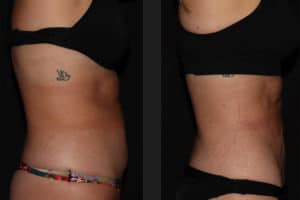Many factors affect a woman’s breasts, including age, pregnancy, nursing, and gravity. Certain genetic characteristics and weight play an even greater role in the size of the breasts.
Is this procedure right for you?
Reduction mammoplasty raises and reduces the size of enlarged, sagging breasts, and can also reduce the size of the areola. This surgery works best for patients whose breasts are disproportionate in size to their frame. Larger breasts tend to sag, lose firmness, or change shape. This procedure should be planned for those no longer planning to become pregnant, to avoid the stretching and sagging of the breasts that occurs with pregnancy. Patients should be mentally and physically healthy and have realistic expectations for the outcome of the surgery.
What does breast reduction entail?
The surgeon will make an incision shaped like a keyhole, remove excess skin, and move the nipple and areola up, then bring down the skin surrounding the areola and stitch it together, reshaping the breast. You will have stitches around the areola and in a vertical line below the nipple. There is a horizontal incision at the lower crease of the breast. The procedure takes about two to four hours.
Does this procedure affect breastfeeding?
You can breastfeed following this surgery. The nipple and areola are not disconnected from the underlying tissue; thus the functionality of lactation remains intact.
How long can I expect the results to last?
While the effects will last for some time, aging, pregnancy, weight changes, and gravity will cause breasts to lose firmness.
What risks are involved?
Though uncommon, complications may include bleeding, infection, and reaction to the anesthesia. Rarely, the surgery can result in permanent loss of feeling in the nipple. This procedure leaves a noticeable scar which can be covered with a bra or swimsuit.
What should I expect from the post-surgery recovery period?
Discomfort, bruising, and swelling in the breasts will dissipate after a couple of days; pain medication will help relieve any pain. Stitches will remain in place for a week or two, then be removed. Patients must wear a surgical bra over a layer of gauze for six to eight weeks (all day and night). You will need to avoid lifting over the head as well as strenuous activity for about a month.







